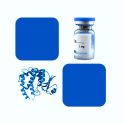
- Remove this product from my favorite's list.
- Add this product to my list of favorites.
Products
Viewed products
Newsletter
 |  |  |  |  |  |

Background
TNF RI (also known as the p60 or p55 TNFR) and TNF RII (the p75 or p80 TNFR) are two distinct type I transmembrane glycoproteins that bind TNF with highaffinity. Both RI and RII are prototypic members of the TNF receptor superfamily and have been designated TNFRSF1A and TNFRSF1B, respectively. Human TNF RII cDNA encodes a 461 amino acid (aa) residue precursor protein with a 22 aa putative signal peptide, a 235 aa extracellular domain, a 20 aa transmembrane domain and a 174 aa cytoplasmic domain. TNFRII is expressed in fetal brain. The protein is produced naturally as a soluble form (sTNFRII). The soluble receptor inhibits TNFα action by competing with cell surface receptors in binding TNFα, thereby blocking its biologic effects. TNFRII is strongly expressed at the cartilage–pannus junction, and plays a major role in a subset of families with multiple cases of rheumatoid arthritis (RA). Further, high plasma levels of sTNFRII were significantly associated with increased incidence of coronary heart disease, independent of established cardiovascular risk factors, and seems to be useful for monitoring the inflammatory activity of sarcoidosis.
Source
Recombinant Human TNFR2, His Tag (TN2-H5227) is expressed from human 293 cells (HEK293). It contains AA Leu 23 - Asp 257 (Accession # AAA36755).
Predicted N-terminus: Leu 23
Molecular Characterization
This protein carries a polyhistidine tag at the C-terminus.
The protein has a calculated MW of 26.0 kDa. The protein migrates as 35-45 kDa when calibrated against Star Ribbon Pre-stained Protein Marker under reducing (R) condition (SDS-PAGE) due to glycosylation.
Endotoxin
Less than 1.0 EU per μg by the LAL method.
Purity
>95% purity as determined by SDS-PAGE
Formulation
Lyophilized from 0.22 μm filtered solution in PBS, pH7.4 with trehalose as protectant.
Reconstitution
See Certificate of Analysis for details of reconstitution instruction and specific concentration.
Storage
For long term storage, the product should be stored at lyophilized state at -20°C or lower.
Please avoid repeated freeze-thaw cycles.
This product is stable after storage at:
-20°C to -70°C for 12 months in lyophilized state;
-70°C for 3 months under sterile conditions after reconstitution.
Bioactivity
Please refer to product data sheet.
(1) "Impact of TNF and IL-33 Cytokines on Mast Cells in Neuroinflammation"
Conti, Ronconi, Lauritano et al
Int J Mol Sci (2024) 25 (6)
(2) "TNFRSF1B Signaling Blockade Protects Airway Epithelial Cells from Oxidative Stress"
Checa, Fiol, Guevara et al
Antioxidants (Basel) (2024) 13 (3)
(3) "Circulating TNF receptor levels are associated with estimated glomerular filtration rate even in healthy individuals with normal kidney function"
Gohda, Murakoshi, Shibata et al
Sci Rep (2024) 14 (1), 7245
Showing 1-3 of 5812 papers.
Follow us